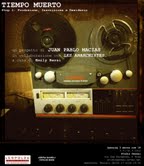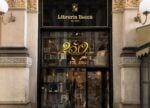Tiempo Muerto

Tiempo Muerto è un progetto itinerante che si pone come obiettivo l’acquisto di un nuovo spazio per la Biblioteca Social Reconstruir rendendola così nuovamente accessibile al pubblico.
Comunicato stampa
Il TEMPO MORTO È INTESO COME UN ARRESTO DI DESIDERIO, UNA PERDITA, MA ANCHE UNA RISERVA DI ENERGIA, POICHÉ IL SIGNIFICATO BASICO DI PERDITA È CREATIVAMENTE SOPPIANTATO NELLA VITA QUOTIDIANA. IL TEMPO MORTO È COME UN MOVIMENTO A RIPOSO, DI INTENSA VIRTUALITÁ.
Tiempo Muerto. Humberto Chávez Mayól, 2004
La Biblioteca Social Reconstruir – BSR – fu fondata nel 1978 a Città del Messico da Ricardo Mestre Ventura, un anarchico veterano della guerra civile spagnola. Nel 1980 fu aperta al pubblico e da allora è diventata la più grande risorsa di testi anarchici dell’America Latina. Nel luglio del 2009, a seguito di un ordine di confisca, i locali della biblioteca - e quindi anche i libri - furono messi sotto sequestro. Grazie a un intervento tempestivo di un fronte comune di frequentatori della biblioteca, si riuscì a trasportare la collezione fuori dagli edifici confiscati. Da allora più di cinquemila libri sono immagazzinati in un piccolo appartamento a Città del Messico, chiusi dentro a scatoloni.
Tiempo Muerto è un progetto itinerante che si pone come obiettivo l’acquisto di un nuovo spazio per la Biblioteca Social Reconstruir rendendola così nuovamente accessibile al pubblico. Una delle idee di base del progetto è di deviare denaro dal mondo dell’arte per finanziare l’iniziativa. Le tappe in programma sono attualmente due: la prima allo Studio Gennai di Pisa e la seconda al Kunstraum di Monaco di Baviera, Germania, tra agosto e settembre 2012.
Nei giorni precedenti all’apertura della mostra lo Studio Gennai di Pisa sarà luogo di collaborazione, creazione e produzione. Dalla cooperazione tra Juan Pablo Macías e il gruppo Musicale Les Anarchistes di Carrara è prevista la produzione di un brano musicale su nastro a bobina che, in una seconda tappa, verrà inciso su 1000 vinili. Lo stock dei vinili è concepito come una scultura il quale profitto si divide in percentuali onorifiche per l’artista, la galleria, la produzione e la maggior parte per l’acquisto del locale. Le pareti della galleria, incise con lo stesso testo adottato nel brano musicale, diventeranno un luogo di proclamazione dei criteri anarchici legati alle teorie di ridistribuzione della proprietà tratti da “Problems of the hour in nine brief studies” di Albert Kimsey Owen (1848-1916), ingegnere, riformatore utopico e fondatore di Topolobampo, in Sinaloa, Messico, comunità ideale basata sui principi anarchici della "Integral Co-operation”.
Con Stop 1: Produzione, Inscrizione e Desiderio, si mette quindi in moto un meccanismo creativo ed economico che ha come obiettivo finale la realizzazione di un desiderio comune, il raggiungimento dell’obbiettivo. Dopo il periodo di occupazione e produzione, la galleria aprirà le porte ai visitatori. Il risultato della collaborazione tra gli artisti sarà quindi visitabile dal pubblico come mostra insieme alla documentazione retrospettiva degli eventi legati alla Biblioteca Social Reconstruir.
Lo sviluppo del progetto verrà documentato regolarmente sul giornale Tiempo Muerto.
“La dichiarazione di voler acquistare uno spazio per la BSR a Città del Messico potrebbe apparire quasi un intento suicida, e forse lo è, ma accettare di farsi intimorire da 30.000 Euro, il costo di un locale a Città del Messico, equivale ad accettare il fatto che il denaro possa essere accumulato solo con il furto perpetrato da grandi stati e corporazioni attraverso l’acquisto di merci non atte a soddisfare bisogni primordiali. Chi può dire che il preservare una delle più grandi biblioteche specializzate in anarchismo non sia di primaria importanza?” Juan Pablo Macías, febbraio 2012
Juan Pablo Macías. Il lavoro di Juan Pablo Macías (1974) esplora la relazione tra sistema da rappresentazione e affettività. Le sue azioni, gli interventi, il lavoro sugli archivi funzionano come transiti affettivi che abbandonano il discorso come via per strutturare formalmente e concettualmente il linguaggio; scegliendo, invece, un programma di azioni che operano direttamente sul corpo biologico, sociale ed economico. Il suo lavoro è stato esposto in importanti musei d'arte in Messico e in tutto il mondo. In Messico ha esibito nel Museo de Arte Universitario - MUAC; Museo de Arte Moderna, Museo Carrillo Gil. Attualmente sta preparando una mostra personale per il Museo Universitario de Ciencias y Artes - MUCA Roma a Città del Messico. All'estero ha esposto nel Centro Nazionale di Mosca per l'Arte Contemporanea (NCCA), nel Musée d'Art Contemporain du Val-de-Marne a Parigi; Playspace Gallery di San Francisco; P74 Gallery di Lubiana; Fondazione Antonio Ratti e Assab One in Italia, Künstlerhaus Bethanien a Berlino; an artist-run-space “Uma Certa Falta de Coerência” in Porto, Portogallo. Il suo lavoro è stato presentato nella mostra itinerante Emergency Biennale in occasione della 10 ° Biennale di Istanbul, e questo 2012 Marzo nel Musée d'Art Moderne de la Ville de Paris in una mostra dal titolo Resisting the Present: Mexico 2000-2012. Ad agosto-settembre 2012 esporrà con una personale nell’ambito della sommer residency al Kunstraum di Monaco di Baviera, Germania.
juanpablomacias.tumblr.com
Les Anarchistes esplodono improvvisamente a Carrara nel 2001. Il loro primo album "Figli di origine oscura" vince il Premio Nazionale Piero Ciampi come miglior disco dell'anno. Seguono "La musica nelle strade" registrato in parte nel carcere di Volterra nel 2005 e "Pietro Gori" nel 2008. Hanno collaborato tra gli altri con Raiz, Antonello Salis, Giovanna Marini, Tuxedo Moon, Compagnia della Fortezza, Armando Punzo, Moni Ovadia, Petra Magoni e Pippo Delbono per il quale hanno scritto parte della colonna sonora per il film "Amore carne" presentato al Festival del Cinema di Venezia.
www.lesanarchistes.org
------------------------------------------------------------------------------
TIEMPO MUERTO
Stop 1: on Production, Inscription and Desire
a project of JUAN PABLO MACIAS
in collaboration with Les Anarchistes
curated by Emily Barsi
Opening 3.3. 2012 18 pm
Studio Gennai
Via San Bernardo 6, Pisa
3.3.- 31.3.12
DEAD TIME IS UNDERSTOOD TO BE AN ARREST OF DESIRE, A LOSS, BUT ALSO A RESERVE OF ENERGY SINCE THE BASIC SENSE OF LOSS IS CREATIVELY DISPLACED IN DAILY LIFE. DEAD TIME IS LIKE A MOVEMENT IN REPOSE, RICH IN VIRTUALITIES.
Tiempo Muerto. Humberto Chávez Mayól, 2004
Library Social Reconstruir - BSR - was founded in 1978 by Ricardo Mestre Ventura, an anarchist veteran of the Spanish Civil War. In 1980, it opened its doors to the public and since then it has become the main anarchist resource in Mexico with its collection of more then 5000 books, amongst them 1000 that are specifically related to anarchism. In July 2009 they were evicted with a seizure order. They managed to get the collection out of the rented property in time to save it. Since then the collection has been closed in boxes and stored in a small apartment in Mexico City.
Tiempo Muerto is a touring project which has as ultimate goal the acquisition of a new location for the Library Social Reconstruir and to render it again accessible to the public. One of the basic ideas of the project is to divert money from the world of art to finance this initiative. At the moment there are two arranged exhibitions: the first one at the Studio Gennai in Pisa and the second at the Kunstraum in Munich, Germany.
In the days before the opening of the show the Studio Gennai becomes the place of cooperation, creation und production. Out of the collaboration between Juan Pablo Macias and the music band Les Anarchistes from Carrara will derive the production of a song on audiotape, which in a second step will be recorded into 1000 vinyl records. The stock of vinyls is designed as a sculpture which profit is divided into honorary percentages for the artist, the gallery, the production, and most of it for the purchase of the new location. The walls of the gallery, engraved with the same text used in the song, will become a place for the proclamation of the anarchic principles connected to the theories of distribution of property taken from “Problems of the hour in nine brief studies” of Albert Kimsey Owen (1848-1916) an engineer, utopian reformer and founder of Topolobampo in Sinaloa, Mexico, an ideal community based on anarchist principles of "Integral Co-operation".
Thus, in Stop 1: on Production, Inscription and Desire, a creative and economic mechanism will be put in motion having as final scope the realisation of a common desire, to reach the goal. After the period of occupation and production, the gallery will open its door to visitors. The result of the collaboration between the artists can be visited by the public as a show together with a retrospective documentation of the events related to the Library Social Reconstruir.
The development of the project will be regularly documented in the newspaper Tiempo Muerto.
“The proclaiming of the objective of buying a space for BSR in Mexico City as an art project might sound suicidal, and probably it is, but to accept to be intimidated by circa 30 000 euro is to accept that money can only be accumulated through stealth by big corporations and states under the basis of the acquisition of not primordial merchandises. Who says that to preserve one of the biggest specialized libraries in anarchism is not a matter of primordial importance? Juan Pablo Macias, february 2012
Juan Pablo Macías The work of Juan Pablo Macías (1974) explores the relation between system of representation and affectivity. His performances, interventions, work on archives and hybrids function like affective transits that decline discourse as a formal-conceptual structure; instead he produces programs that operate directly on the biological, social and economic bodies. His work has been shown in major art museums in Mexico and around the world. In Mexico he has shown in Museo de Arte Universitario - MUAC; Museo de Arte Moderno; Museo Carrillo Gil. He is preparing for this summer a solo show for Museo Universtitario de Ciencias y Artes - MUCA Roma in Mexico City. Abroad in Moscow’s National Center for Contemporary Art (NCCA); Musée d’Art Contemporain du Val-de- Marne in Paris; Playspace Gallery in San Francisco; P74 Gallery in Ljubljana; Fondazione Antonio Ratti and Assab One in Italy; Künstlerhaus Bethanien in Berlin; at the artist-run-space A Certain Lack of Coherence in Porto, Portugal. His work was featured in the Emergency Biennale traveling exhibition at the 10th Istanbul Biennial, and this March 2012 in Musée d'Art Moderne de la Ville de Paris in a show entitled Resisting the present: Mexico 2000-2012. In sommer 2012 he will exhibit in a personal show at the Kunstraum in Munich Germany.
juanpablomacias.tumblr.com
Les Anarchistes. The band Les Anarchistes was formed in Carrara in 2001. Their first album "Sons of an obscure origin" won the National Award “Piero Ciampi” for best Album of the Year. This Albume was followed by "The music in the streets" recorded in the prison of Volterra in 2005 and "Pietro Gori" in 2008. They collaborated with Raiz, Antonello Salis, Giovanna Marini, Tuxedo Moon, Compagnia della Fortezza, Armando Punzo, Moni Ovadia, Petra Magoni. In 2011 they collaborated with the italian film director Pippo Del Bono writing a song for the film "Amore Carne" presented at the Venice Film Festival.
www.lesanarchistes.org



